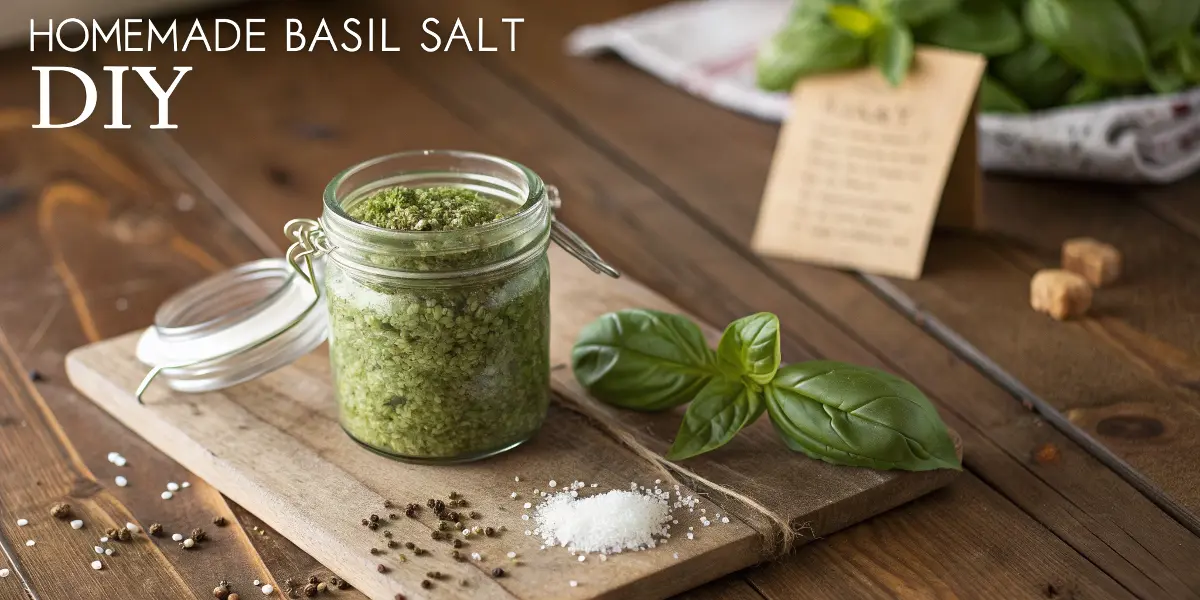Start with a garden story—imagine basil’s fragrance filling your windowsill and the urge to preserve that bliss. Introduce Homemade Basil Salt DIY as the elegant solution: a vibrant, aromatic salt perfect for cooking, finishing dishes, or gifting. Use “DIY basil salt” or “how to make basil salt” early and mention its versatility in recipes and its garden-to-table aesthetic.
Print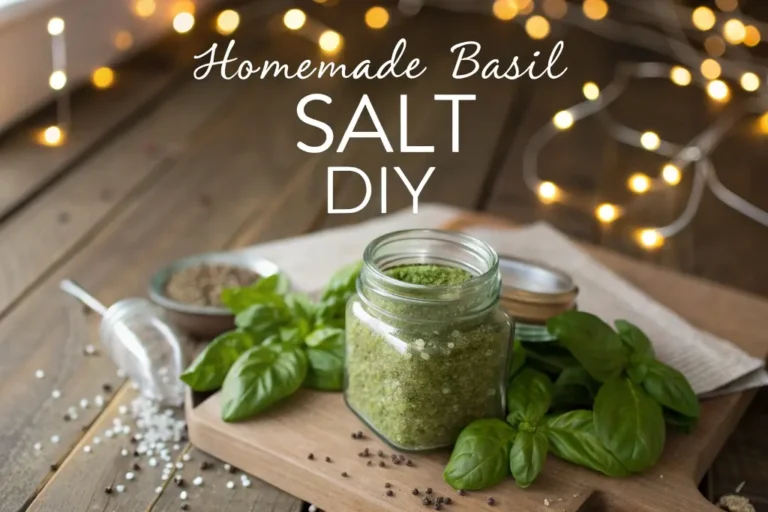
Homemade Basil Salt DIY: Garden-Fresh Flavor You’ll Love
This homemade basil salt is a fragrant, garden-fresh seasoning perfect for sprinkling on everything from roasted veggies to popcorn.
- Total Time: 35 minutes
- Yield: 1 cup
Ingredients
2 cups fresh basil leaves
1/2 cup coarse sea salt
Instructions
1. Combine basil leaves and salt in a food processor and pulse until blended.
2. Spread mixture on a parchment-lined baking sheet.
3. Let air-dry overnight or bake at 200°F for 30 minutes.
4. Cool and crumble into jar. Store airtight.
Notes
Use high-quality salt for best flavor.
Refrigerate for longer storage up to 6 months.
- Prep Time: 5 minutes
- Cook Time: 30 minutes
- Category: Condiments
- Method: Dehydrated
- Cuisine: Herbal DIY
- Diet: Vegan
Table of Contents
Looking for more plant-based dinner inspiration? Explore our Vegan Dinner Recipes Guide for easy vegan meals, cozy casseroles, slow cooker ideas, and a simple 7-day vegan dinner plan.
Why Make Your Own Basil Salt?
Garden-fresh flavor meets preservation
If you’ve ever grown basil in a sunny kitchen window or a backyard pot, you know that rush of earthy, peppery aroma that fills the air. But basil wilts fast—its peak flavor doesn’t last long once picked. That’s exactly why homemade basil salt is such a gem. It captures all that summery essence and preserves it in a format you can enjoy year-round.
Unlike freezing or drying, blending basil with coarse salt seals in its essential oils. The salt naturally dehydrates the leaves, locking in that just-picked flavor. In fact, this method is often more flavorful than dried basil and more versatile than frozen herb cubes. We’ve used it to elevate dishes like our Ribbon Carrot Salad or tomato-topped focaccia—just a pinch can transform a plate.
Crafting it yourself means no preservatives, no anti-caking agents—just pure garden goodness. It’s perfect for anyone trying to cook cleaner, or anyone with a flourishing herb garden and not enough ways to use it before the leaves turn limp.
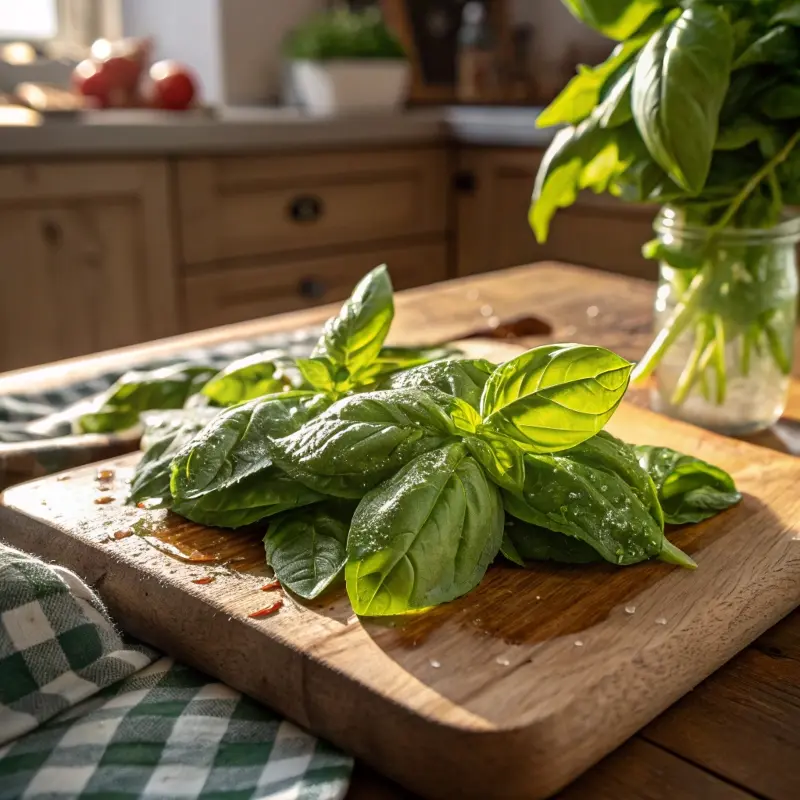
Uses & culinary magic
Once you’ve made it, the creative possibilities multiply. A sprinkle of basil salt over roasted tomatoes? Magic. Dust it over eggs, grilled veggies, avocado toast, or even popcorn for a savory surprise. It’s also amazing on caprese salads or pasta—basically, any dish that loves a little herbal zing.
We’ve paired this salt with vibrant recipes like our Japanese Pink Salt Recipe and even in finishing touches on proteins like in our Wagyu Ground Beef Recipe. Think of it as your homemade upgrade to fancy gourmet finishing salts—but fresher, greener, and entirely yours.
How to Make Basil Salt Step by Step
Simple ingredients, maximum flavor
Making your own basil salt takes just two ingredients: fresh basil and coarse sea salt. That’s it. But don’t let the simplicity fool you—this green-speckled blend packs a vibrant punch. Start with organically grown basil if possible. The leaves should be deep green, free from yellowing or spots. Then pair with high-quality salt—like flaky sea salt or Himalayan pink salt—for better texture and trace minerals.
We love pairing this idea with the healthy benefits discussed in our Celtic vs Himalayan Salt guide—because your salt base matters as much as the herb.
To make it: combine 1 cup of packed basil leaves with 1/2 cup of coarse salt in a food processor. Pulse until it forms a damp, green mixture. Spread the blend thinly on a parchment-lined baking sheet and let it dry overnight—or place in a 200°F oven for 20–30 minutes until dry. Once cooled, break it up and store in an airtight glass jar.
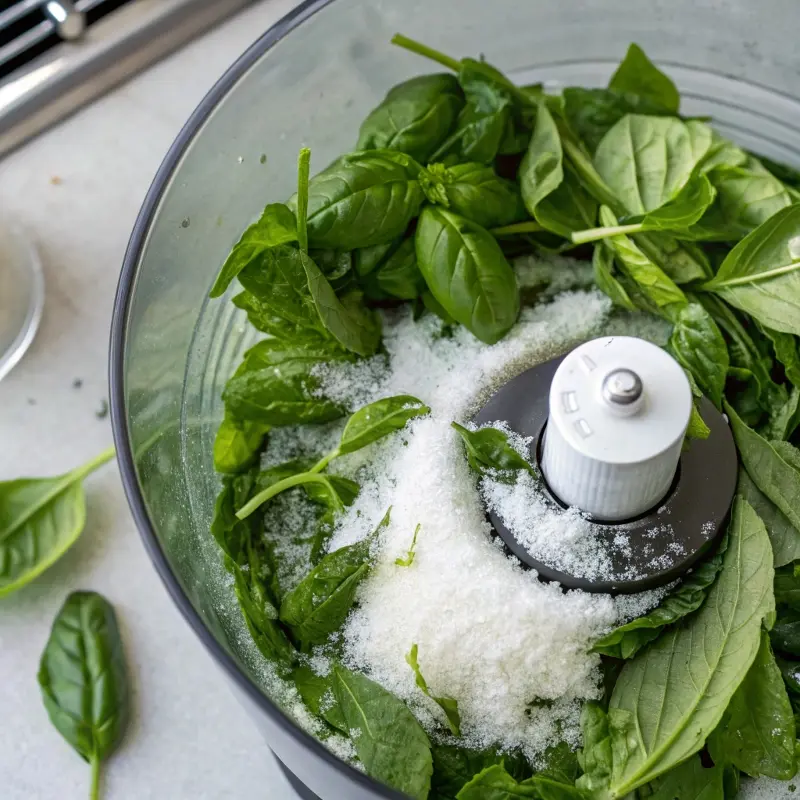
Pro tips for perfect results
Don’t over-process the basil or you’ll end up with a paste instead of a crumbly texture. If you want added flair, mix in lemon zest or garlic powder after drying—like we do for our Cowboy Butter or protein-rich flavor blends.
Make small batches to retain maximum potency. Stored in a cool, dry pantry, it’ll last up to 3 months while keeping its color and scent. And if you’re gifting it? Mason jars, twine, and a handwritten label turn it into the ultimate seasonal DIY.
We’ve even layered it on Pink Salt Weight-Loss Recipes to make low-sodium meals feel more indulgent.
Creative Uses for Basil Salt in Everyday Cooking
Beyond the basics: elevating everyday meals
Once you’ve made your own basil salt, it quickly becomes the MVP of your spice cabinet. Think of it as a shortcut to fresh herb flavor—without needing to wash, chop, or worry about wilting leaves. Just a pinch wakes up simple meals.
Sprinkle it on warm, just-out-of-the-toaster sourdough. Dust it over a bowl of summer strawberries drizzled with balsamic vinegar. Use it to finish dishes like grilled chicken, tomato flatbread, or even creamy polenta. In our kitchen, it’s taken the place of plain salt in everything from eggs to compound butter—just like in our Cowboy Butter variations.
Add it to homemade dressings for an herbaceous edge, or mix with softened butter for a rich spread you can serve with roasted vegetables or corn on the cob. It’s especially beautiful when dusted onto Vegan Mushroom Recipes for that earthy-meets-fresh flavor profile.

Seasonal pairings and fresh inspiration
In the summer months, basil salt pairs beautifully with garden recipes like our Ribbon Carrot Salad, heirloom tomato slices, or grilled zucchini. Come fall, try using it in savory breads, roasted root vegetables, or sprinkled on top of your favorite Keto Sweet Toasts.
It also makes an elegant finishing touch for cocktail rims—imagine a white peach sangria with a basil-salt sugared rim or even a savory Bloody Mary with basil heat.
Use it to garnish deviled eggs, sprinkle over risotto, or boost your next tray of roasted nuts. The options are endless, and each one brings that homegrown freshness straight to your fork.
Storing, Gifting, and Long-Term Tips for Basil Salt
How to keep basil salt fresh for months
After all the effort of crafting your homemade basil salt, proper storage ensures it keeps both color and punch. Once dried, your blend should feel crumbly—not damp. If any moisture lingers, return it briefly to the oven. Moisture is the enemy of freshness here.
Store your basil salt in airtight glass jars. A mason jar works beautifully, especially the kind with rubber gasket seals. Keep it away from heat and sunlight—your pantry or spice drawer is ideal. When stored properly, it’ll hold vibrant flavor for up to 3 months. Use a clean spoon each time to avoid contamination.
We recommend labeling the date on each jar and rotating batches. You’ll be surprised how often you reach for it once you see what it does for your Wagyu Ground Beef or even simple egg dishes.
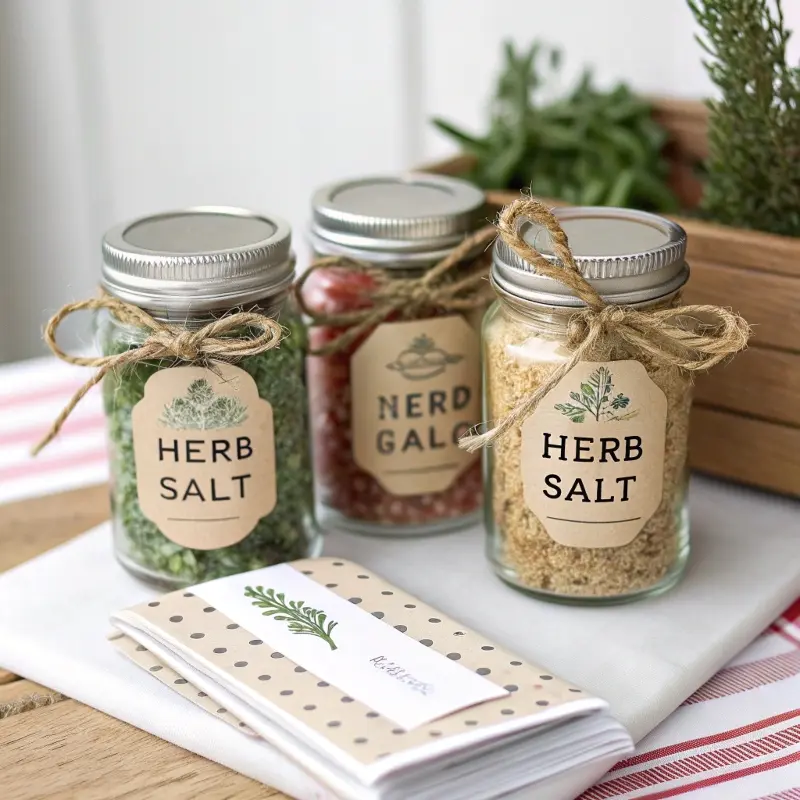
Gifting and DIY add-ons
Basil salt isn’t just useful—it’s beautiful. That green-flecked texture in a little jar is a perfect homemade gift. Add a sprig of fresh basil and a handwritten recipe card tied to the jar with string, and you’ve got a thoughtful DIY anyone would love.
Consider making a trio set: basil salt, rosemary salt, and lemon-thyme salt. Package them in small jars and gift as hostess sets, holiday baskets, or summer BBQ tokens. We’ve had huge success pairing this idea with gifting-ready concepts like our Pink Himalayan Salt & Honey or Bariatric Tea for wellness-focused bundles.
Finally, for long-term storage beyond 3 months, refrigerate the dried salt in sealed jars to slow degradation. Just bring to room temperature before use to avoid clumping.
FAQs about Homemade Basil Salt
How long does homemade basil salt last?
When stored properly in an airtight jar away from heat and light, basil salt can last up to 3 months with full flavor. For longer storage, refrigerate it in a sealed container to maintain freshness.
Can I use other herbs besides basil?
Yes! Rosemary, thyme, oregano, and sage all work beautifully in DIY herb salts. You can even create blended salts with lemon zest or garlic for added dimension, similar to our Cowboy Butter flavor profiles.
Does basil salt taste like fresh basil?
It has a deep, concentrated basil aroma and flavor—somewhere between fresh and dried basil. Because the oils are preserved, the result is often more fragrant than dried herbs.
Can I make basil salt without a food processor?
You can finely chop the basil by hand and mix it with salt, then let it dry on a baking sheet. The texture won’t be as fine, but it’s still flavorful and rustic.
Conclusion
Homemade basil salt is more than just a pretty jar—it’s flavor preserved with purpose. Whether you’re looking to elevate roasted veggies, gift something heartfelt, or stretch your summer garden just a little longer, this easy DIY delivers. In just minutes, you’ve got a vibrant green salt blend that transforms everything it touches.
We’ve used it in meals that range from Keto Sweet Toast to Japanese Pink Salt Recipes, and every time it brings that touch of brightness only fresh herbs can offer.
Ready to turn your basil into a pantry staple? This DIY recipe proves: sometimes the simplest things really are the most powerful.
Basil is a rich source of polyphenolic compounds—especially rosmarinic and caffeic acids—that act as natural antioxidants and antimicrobial agents. These compounds help prevent oxidation and microbial spoilage in food, enhancing the preservation quality of herbal salt blends like this DIY basil salt recipe. Learn more about the science of basil’s preservative action.

